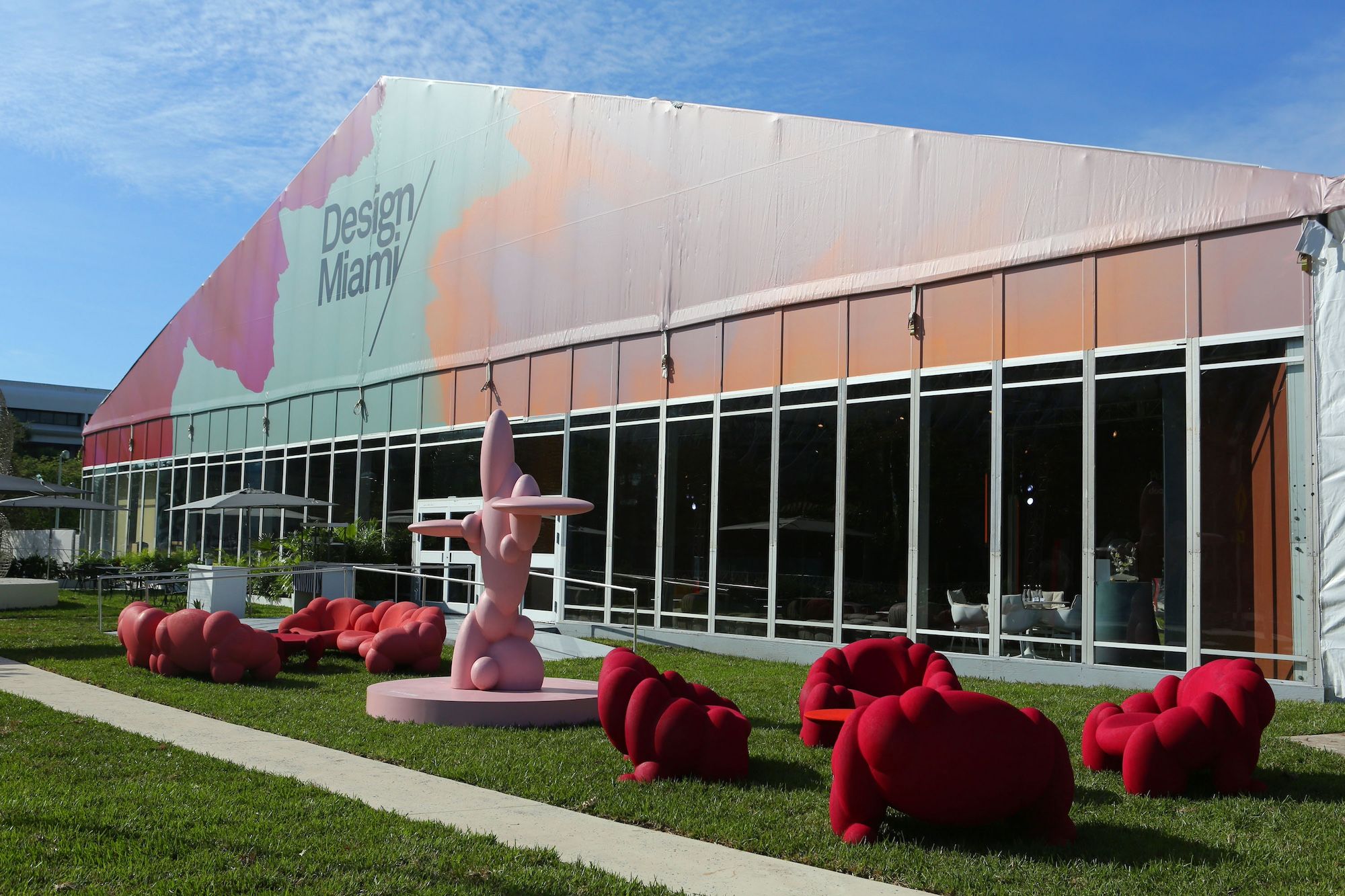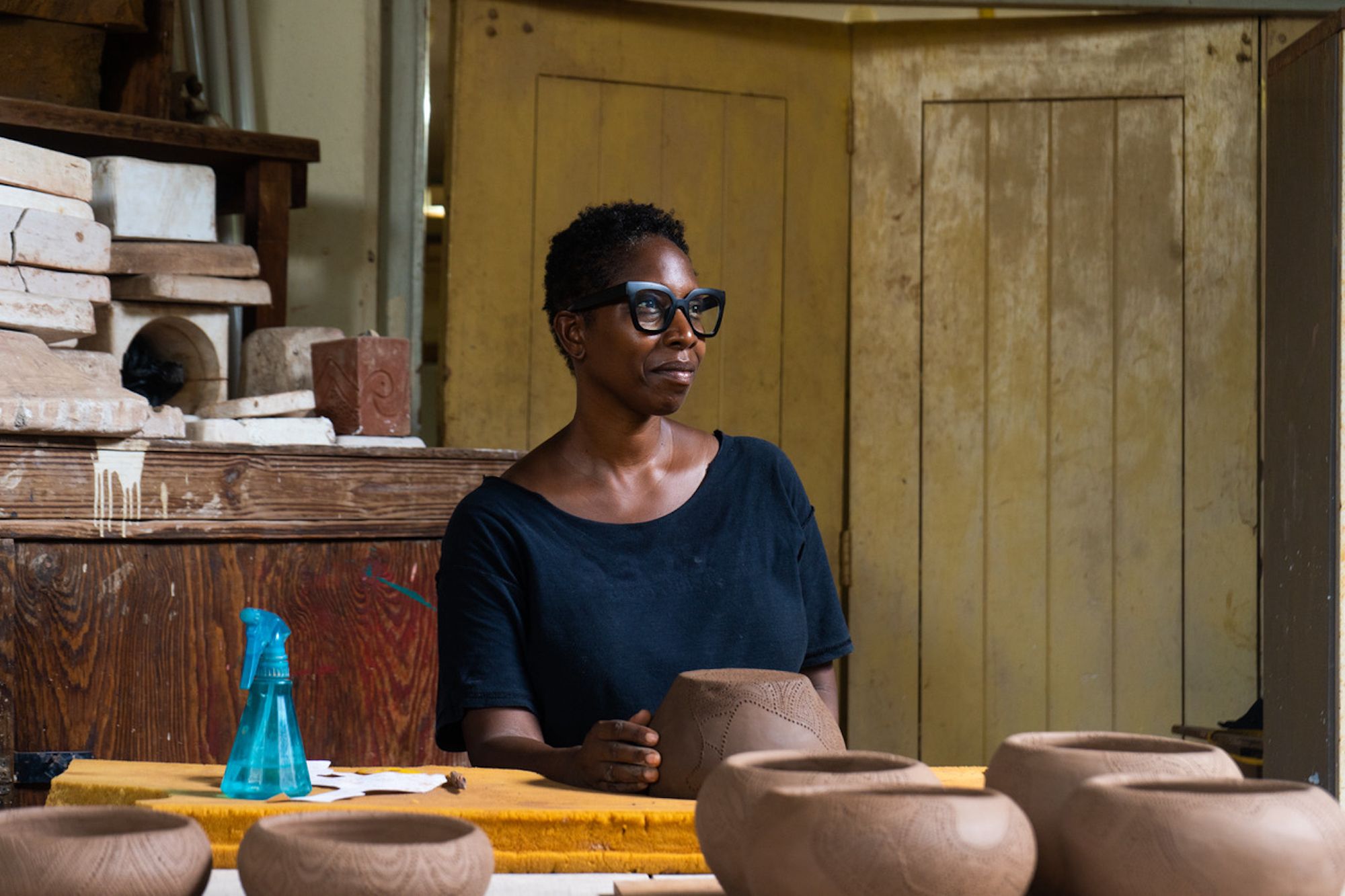SPOTLIGHT: WHERE WE STAND NOVEMBER 29 2023
by Wava Carpenter
The Silicon Valley-based architect on challenging the status quo to build a better future
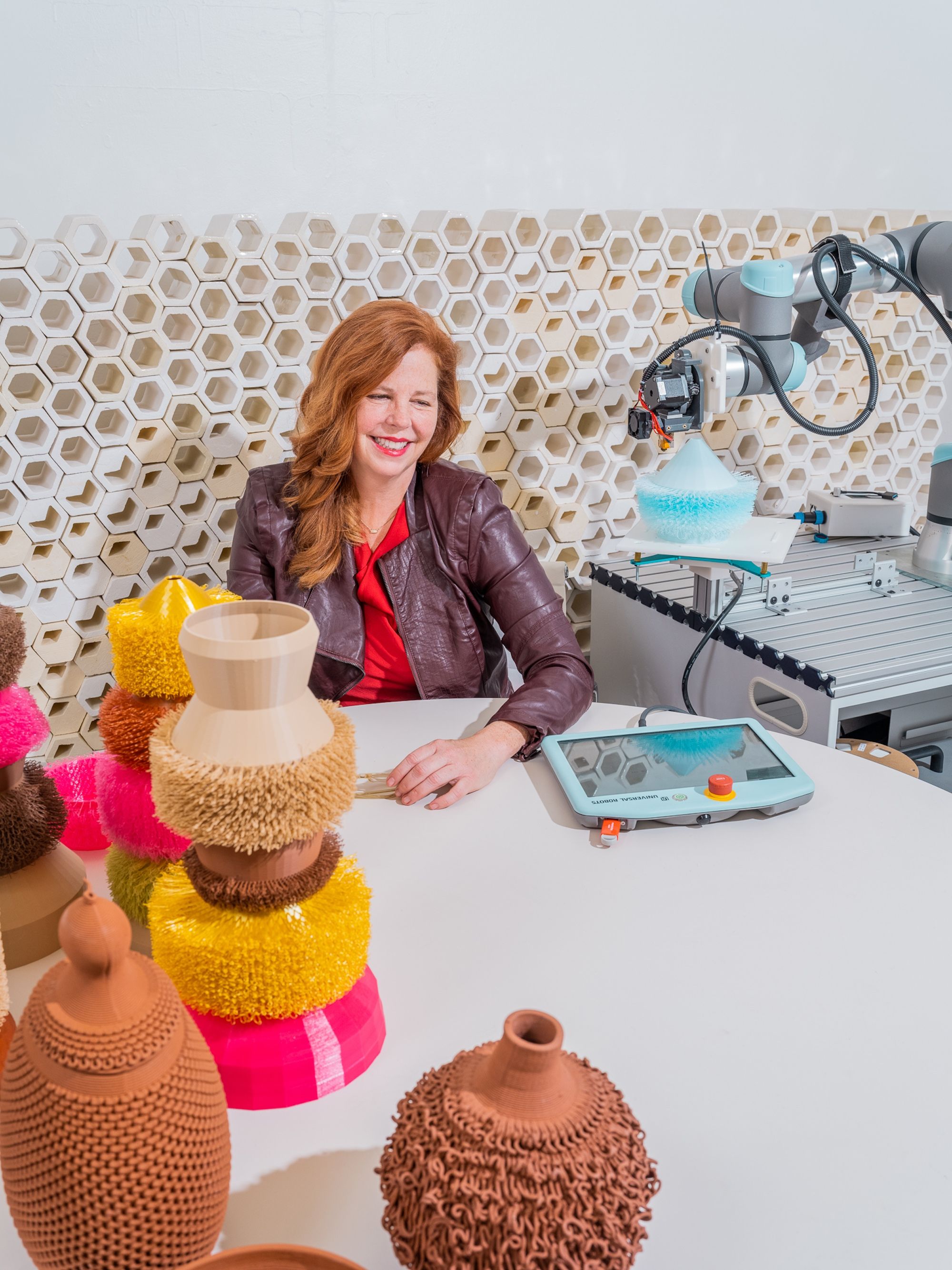
ARCHITECT, INTERIOR DESIGNER, AND EDUCATOR VIRGINIA SAN FRATELLO
Photo © Kelsey McClellan; courtesy of Rael San Fratello
To augment the Design Miami/ 2023 curatorial theme Where We Stand, we’ve put together an editorial miniseries featuring interviews with exceptional creatives whose practices exemplify socially engaged, narrative-driven design approaches. These thought-provoking design thinkers all have works on view in the upcoming fair and, for this series, have responded to our queries with edifying insights into design’s role in strengthening our connections with one another. Today we’re proud to share our conversation with architect, interior designer, and educator Virgina San Fratello, partner at Rael San Fratello and Emerging Objects and Chair of the Department of Design and the Department of Art & Art History at San José State University in Silicon Valley.
It’s not everyday that a design installation with a forty-minute lifespan captures the world’s imagination. But that’s precisely what happened four years ago when design duo Rael San Fratello erected their Teeter-Totter Wall at the US-Mexico border. On July 28, 2019, against the backdrop of the Trump administration’s tragic family-separation policy, Rael San Fratello invited the public on both sides of the divide to play together on vibrant pink seesaws that ran through and pivoted on the border wall.
The studio documented the project in photographs and video, capturing laughing children and adults delighting in the opportunity to overcome the US government’s inhumane barrier, which has for years kept loved ones apart. The images beautifully conveyed the project’s larger message: what happens on one side of the border directly impacts the other. News of the short-lived yet poignant event spread from social media and local TV to national and international outlets, often bringing tears to the eyes of viewers and eventually earning Rael San Fratello an array of honors and speaking engagements from prestigious art, architecture, and design institutions, including the Design Museum London’s Beazley Design of the Year Award.
Sensitive, principled, progressive, and inventive, Teeter-Totter Wall is emblematic of San Fratello's wider practice—both in collaboration with Ronald Rael and solo—as well as in her role as a design educator. She has become an industry thought leader, not only for her design-as-activism approach, but also thanks to her innovative work with 3D printing, pioneering ways to harness the technology's potential to reimagine more affordable and ecological housing and to uncover new uses for sustainable materials, like chardonnay grape skins, salt, sawdust, and adobe. Works from her studio's visionary portfolio are represented by Cristina Grajales and can be found in the permanent collections of the Museum of Modern Art, Cooper Hewitt, SFMOMA, LACMA, CSMVS Museum, and Design Museum London.
Read on to learn more about the future that San Fratello is working to build and the values she’s modeling along the way.
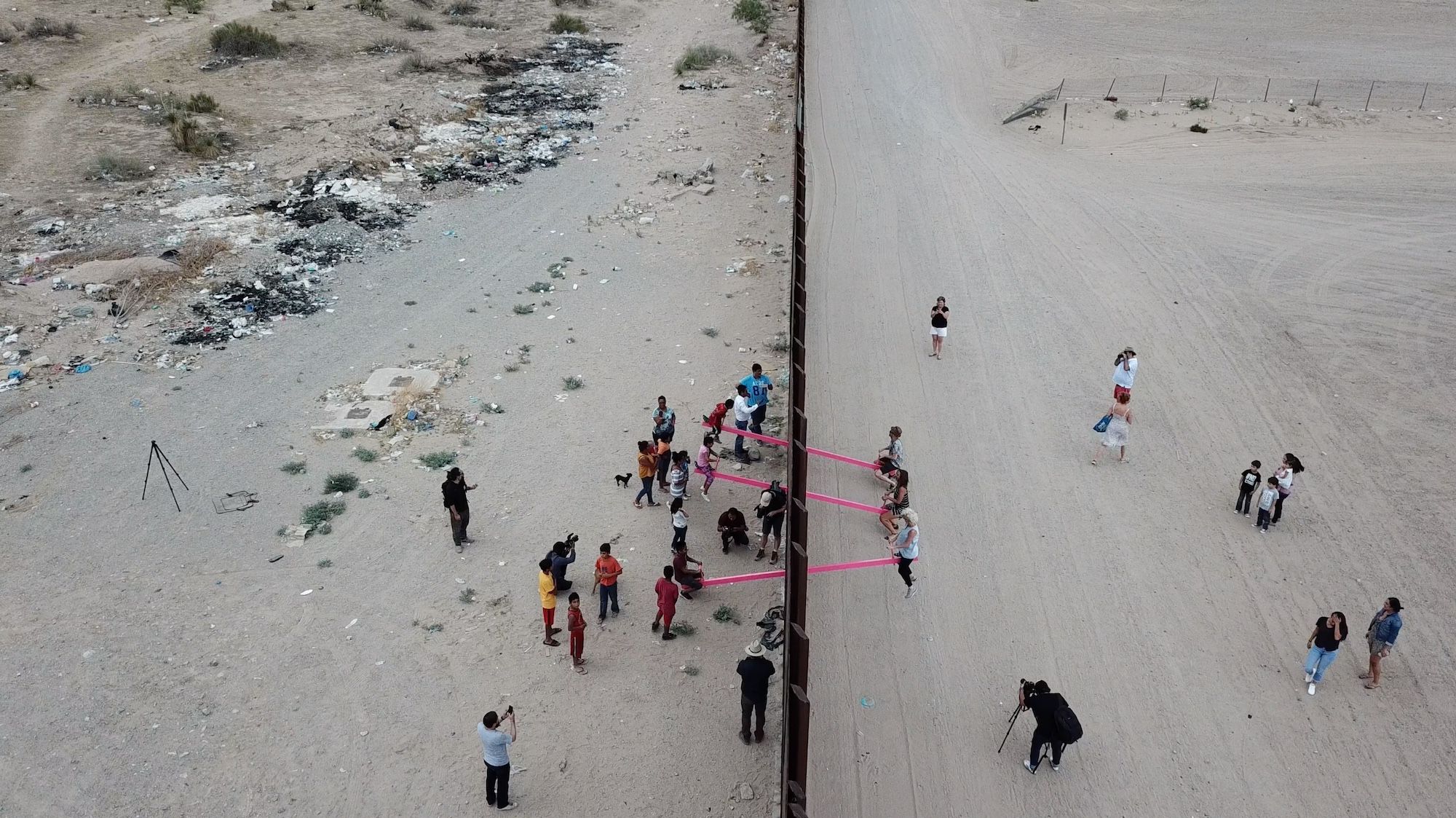
TEETER-TOTTER WALL BY RAEL SAN FRATELLO
Photo courtesy of Rael San Fratello
Wava Carpenter/What project(s) are you most proud of to date and why?
Virginia San Fratello/ One of the projects I am most proud of is the pink teeter-totter installation, because it used joy and play to bring families from both sides of the border together—especially women and children—at a time when children were being taken away from their parents. For me, this project speaks to the political relation between us and our neighbor to the south, demonstrating through play that what happens on one side has consequences on the other. Teeter-tottering demands that players work together to create mutual success and enjoyment. Color has always been important in my work, and in this instance the color pink was chosen because it means that we remember the women who were killed in the femicides in Juárez, the city closest to the installation. This started a conversation about what it means to do projects here, at the wall, and the violence that the wall eludes.
Teeter-Totter Wall has in turn inspired other projects. For instance, there’s been a number of poems and songs written about it, including a rap song; replications of it have been created in different countries; and visual illustrations of it have been developed across the world, from political cartoons to illustrations on t-shirts. Many academic essays were written that analyze, criticize, and celebrate the project (though frequently without a deep understanding of the project, despite their academic proclivities).
The Smithsonian made a documentary that included this project, and HBO produced a movie called The Immigrant Lawyer—the movie poster featured a pink teeter-totter, and the last scene is a shot of a family on a teeter-totter. In Carrera, Italy, there was a playground developed in which they built the wall and inserted the pink teeter-totter inside.
Rael San Fratello was recently asked to replicate the project at full scale in Lisbon, including a component where people have the opportunity to converse and experience what the wall really is and what the meaning behind the project is. After deinstallation, they will create a still, sculptural artwork that transforms the wall into a house to show that there’s a post-wall world—where the wall could become something else.
I felt an incredible amount of elation during the project. Not only that, I could feel the joy oozing out of everyone who was at the wall that day playing with me! It was a very special day surrounded by excitement, and I would love to be able to create that feeling not only for myself but for others again.
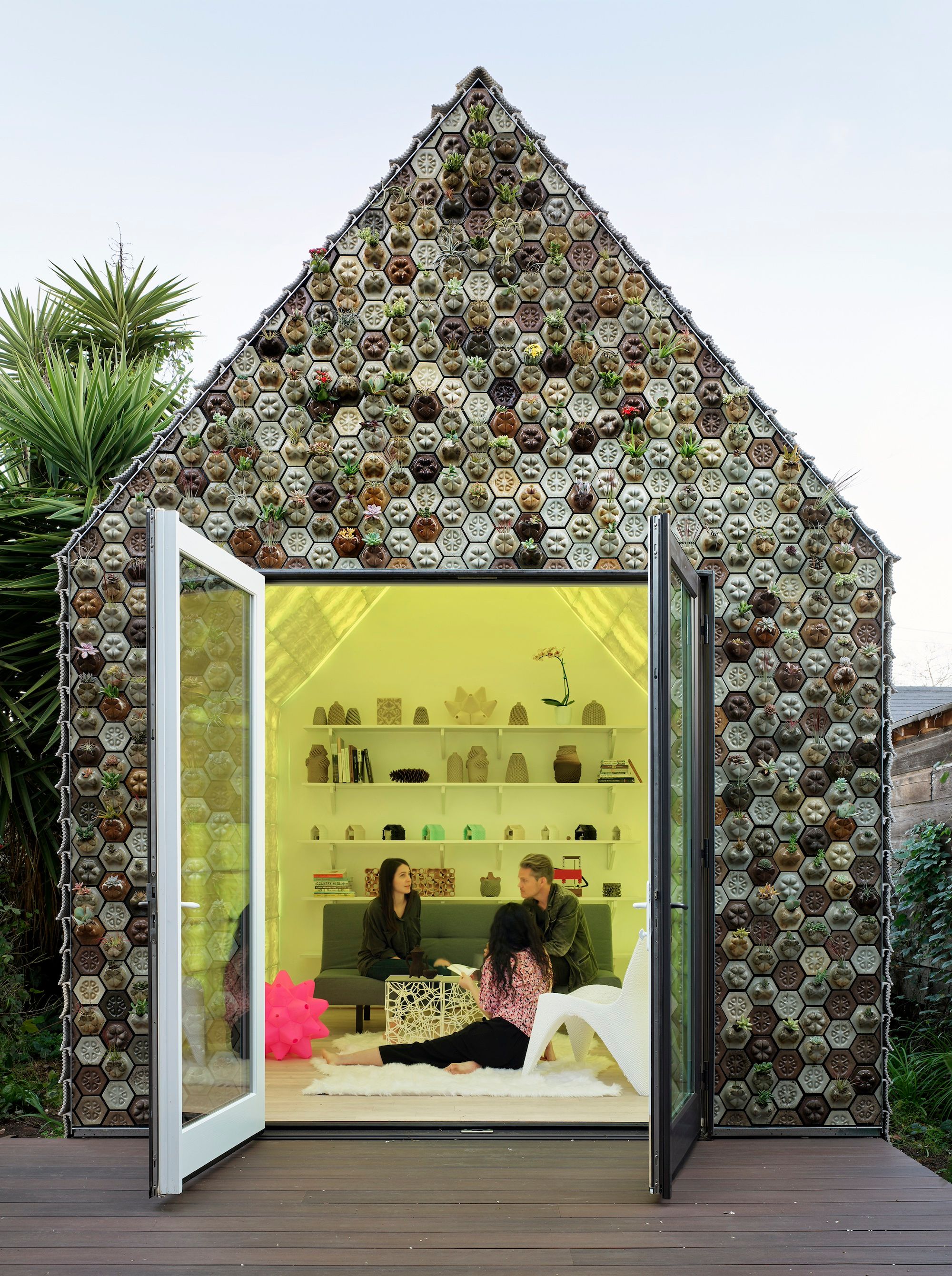
3D-PRINTED CABIN, MADE FROM PLANT-FILLED, 3D-PRINTED TILES, ONE OF RAEL SAN FRATELLO'S PROJECTS FOR EMERGING OBJECTS, THE DUO'S 3D PRINTING MAKE-TANK
Photo © Mathew Millman; courtesy of Rael San Fratello
WC/ What changes are most urgently needed in the way design is taught today?
VSF/ I am an educator. I teach architecture and design classes at San José State University, and I occasionally teach at other universities around the country—most recently MIT in Cambridge and Pratt Institute in Brooklyn. One thing I try to do with my students is help them recognize that their diverse personal histories, interests, and lived experiences are the most powerful tools they have to bring to their creative work. This is what will make their work unique and meaningful.
Students often come to class thinking that their goal is to fit into the existing norms, standards, and descriptions that define their discipline; that this is what will make their work “real” and “valuable.” They want to fit in instead of stand out. But if we want to make change—and as designers, I think that most of us do—then we need to question the status quo. We need to celebrate and respect our differences and understand that diversity enhances creativity. It encourages the search for novel information and perspectives, leading to better decision-making and new ways of thinking and problem-solving.
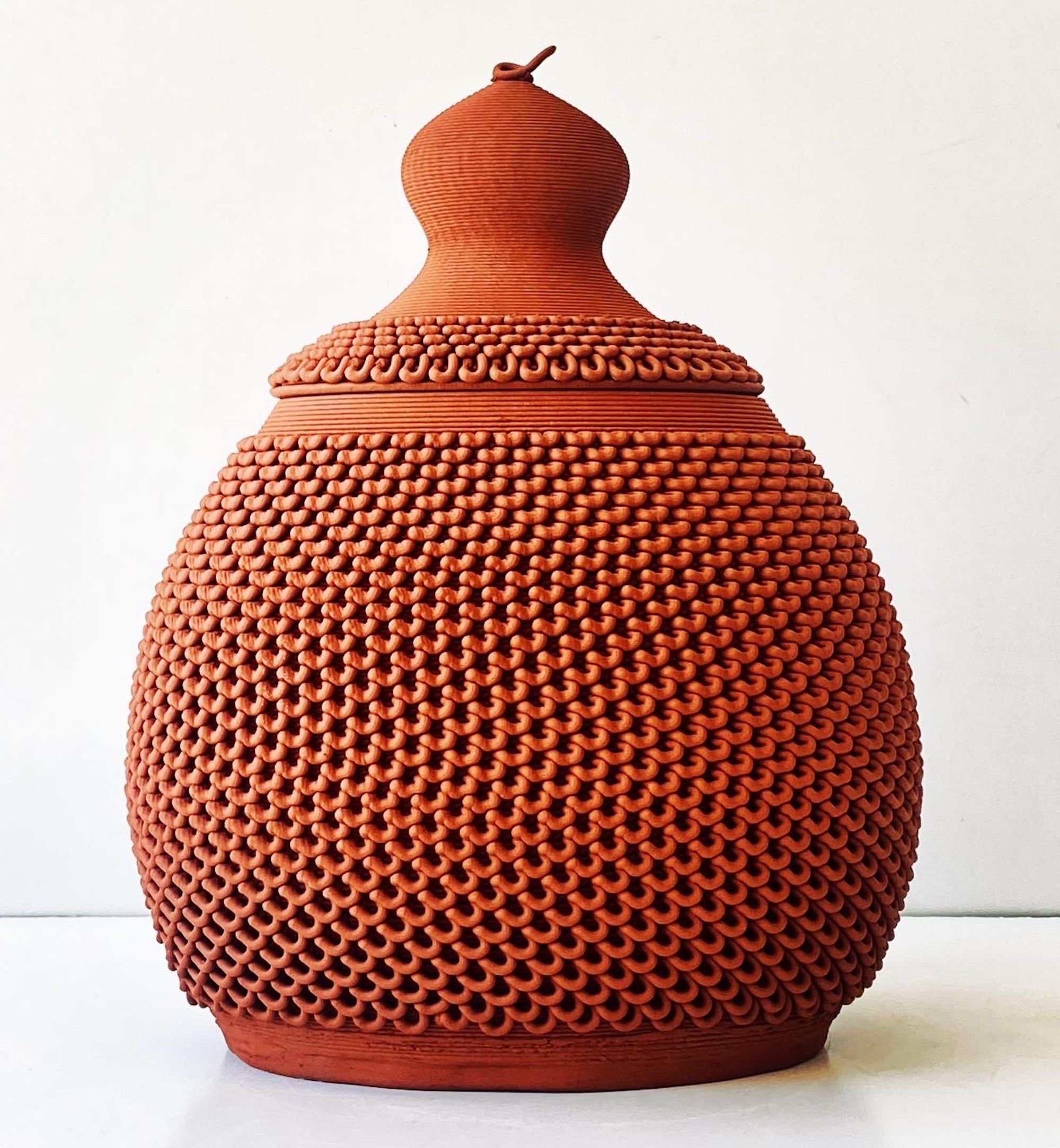
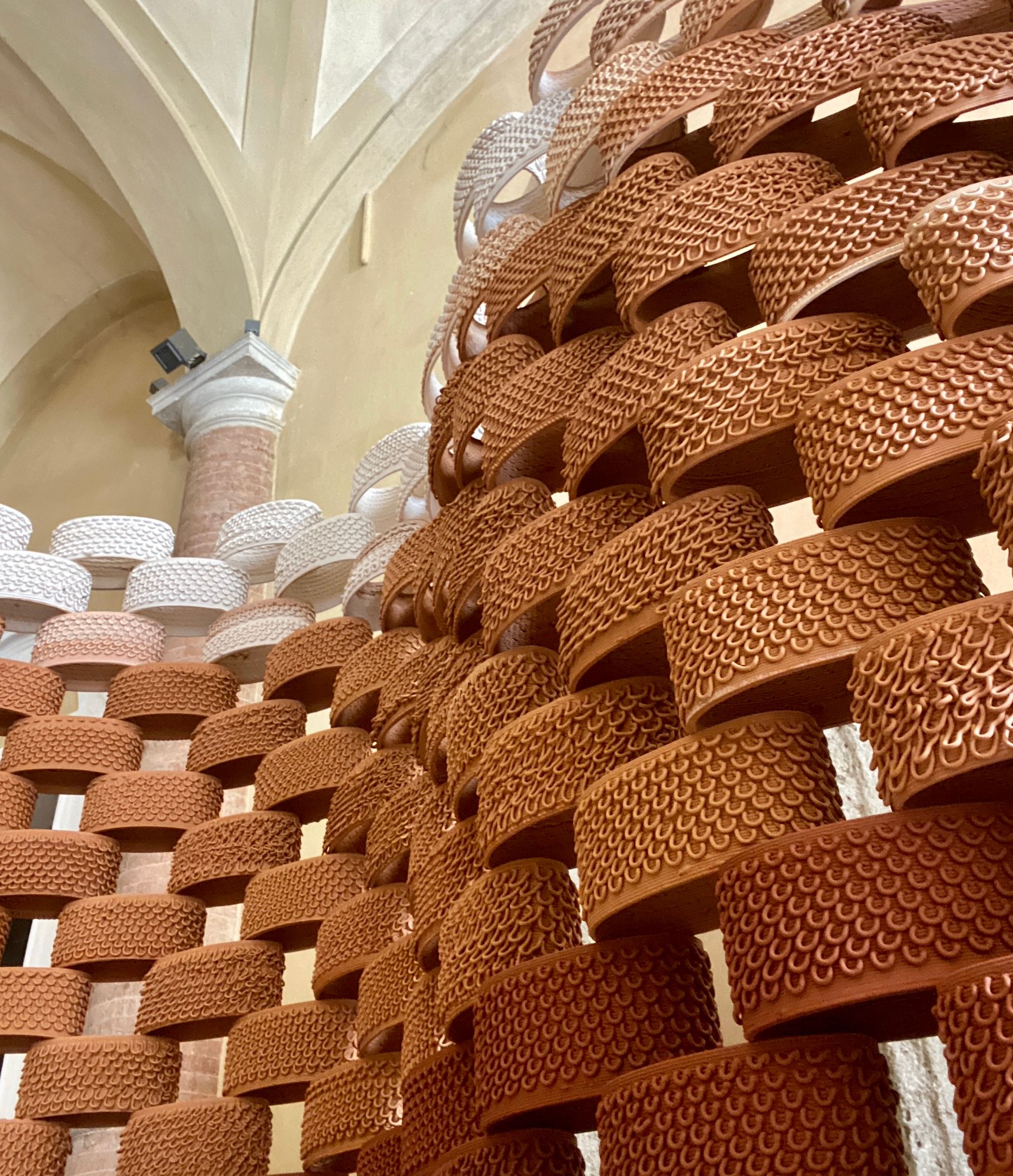
SAN FRATELLO PROJECTS FOR EMERGING OBJECTS: SAN FRATELLO BISCOTTI JAR, COMPOSED OF 3D-PRINTED CLAY FROM SICILY (LEFT); AND FUTURE ARCHEOLOGIES, FEATURING 3D-PRINTED BRICKS, ON VIEW IN FAENZA, ITALY (RIGHT)
Photos courtesy of Virginia San Fratello
WC/ How can looking to our roots—heritage, community, the land beneath our feet—inform our way forward?
VSF/ For me, as a designer, this is quite literally how I work, and I will describe two examples that demonstrate this. The first is a vessel that I call the San Fratello Biscotti Jar, which is 3D-printed out of my ancestral clay from San Fratello, Sicily.
In 2021, my search for ancestral clay led me to Sicily, where my grandfather was born before he immigrated as a child to the US through Ellis Island in the early 1900s. Like many immigrants, his parents did not speak English, and when they were asked for their surname, they said San Fratello, which is a small town on a hilltop in the Nebrodi Mountains of Messina, a province in North-East Sicily. I think it’s natural sometimes to confuse who you are with where you come from—and maybe that’s not a bad thing! We consume the terroir of the places we live, and it becomes a part of our genetic makeup, which is then passed on from one generation to another. My genes were telling me there was clay in or nearby San Fratello, and so I decided a visit was in order.
I flew to Palermo and restlessly scoured the city searching for information from local potters about where local clays could be found. I had the good fortune to come across a collective called MUD lab, and the owner pointed me to a quarry just 30 minutes away from San Fratello. I drove there and was generously gifted 25 kilos of the local earthenware clay, which I used to fabricate the San Fratello Biscotti Bar. It’s an object that looks both back and forward simultaneously, crafted of my ancestral clay and representing my journey to discover the geology of my ancestors.
The vessel is an investigation into a traditional form—an ancient Mediterranean storage container—which is reinterpreted by exploiting the opportunities and limitations of 3D printing with clay. For me, this journey helped me learn more about my genealogy and connect with my living relatives, while also finding a new way forward in my work. It helped me see the next steps along my creative path. I almost exclusively now 3D print with local clays, wild clay, and clays that I have a personal connection to.
In the 20th century, legendary North Bay potter Edith Heath pioneered the use of local clay in contemporary commercial ceramic tableware, using material excavated from the clay pits in Lincoln and Ione, California. She called the premixed, commercial white clay that was ubiquitous at the time “gutless,” and I tend to agree with her. Using “my land beneath my feet” has given me courage, determination, and the freedom to express myself in a way that I feel I lacked before. It has brought a cultural value to my work that would not otherwise be there.
The second project is called Casa Covida, designed by myself and my creative partner Ronald Rael. The Casa Covida is a house 3D-printed out of earth—literally the ground beneath our feet. We designed and built the house as a space for cohabitation during the time of covid; as an experiment in combining 3D printing with indigenous and traditional building materials and methods. The project looks at new and ancient ways of living.
This experimental case-study house is situated in the high alpine desert of Colorado’s San Luis Valley, where adobe—a combination of sand, silt, clay, water, and straw dried in the sun—is the traditional building material. The house comprises three spaces, each for two people to sleep, bathe, and gather around fire and food. The spaces have openings to the sky, the horizon, and the ground.
In 2012, the Smithsonian Institute celebrated 40 years as the world’s largest museum and research center by outlining 40 predictions for the next 40 years. The number one thing you need to know about the next 40 years, according to the Smithsonian, is that “sophisticated buildings will be made of mud.” This makes me think that scientific reasoning is finally starting to catch up with the thousands of years of indigenous knowledge, and I’m excited to be alive, designing, and creating at this moment of intersection—a moment when we can embrace technology and how it makes our lives easier and more connected while also building on material traditions that respect the balance of our ecosystem.


RAEL SAN FRATELLO'S CASA COVIDA IN COLORADO’S SAN LUIS VALLEY, AN ADOBE HOUSE THAT COMBINES 3D PRINTING WITH INDIGENOUS AND TRADITIONAL BUILDING MATERIALS
Photos © Elliot Ross; courtesy of Rael San Fratello
WC/ What is the future vision you are working toward?
VSF/ This is a hard question to answer, but I will be aspirational and try! I’m working in my own small way towards a creative practice that moves out of the studio and into the landscape, one that is more harmonious with nature. A creative practice that is deeply personal yet relatable and accessible. The creation of a body of work that will stand the test of time, one that embraces what is old and what is new and is a reflection of this present moment. I want to embrace material practices that contribute to the restoration of our earth.
I want to use my design powers to tear down walls and create togetherness in ways that are big and small. And maybe most importantly, I want to inspire joy and happiness, because ultimately, I think that is what we are all working for.
Stay tuned for more Where We Stand interviews in the coming days.
This editorial series was conceived and curated by Anna Carnick and Wava Carpenter of Design Miami and Anava Projects as an exploration of the Design Miami/ 2023 curatorial theme Where We Stand.
About Where We Stand: Reflections on Place, Purpose & Community: Objects are anthropological markers of time and place. Through material, process, and form, every object tells a story—not only of the makers and societies responsible for their creation, but also of the human experience more broadly. Responding to the complexities that define our current timeline, Where We Stand explores the storytelling power of design and, in turn, its potential for nurturing connectivity. As we celebrate objects from around the globe inspired by place, identity, and heritage, we hope to prompt questions—and potential answers—to help us navigate this complex, polarized period in history: How do objects narrate human progress? And how can we harness the beauty and power of our most intimate, rooted bonds, individually and collectively, to realize a more perfect world to call our own?
Click here to purchase tickets to attend Design Miami/ 2023, open to the public December 6-10 at Convention Center Drive & 19th Street in Miami Beach.
